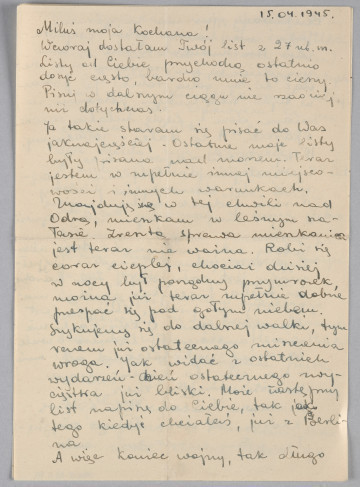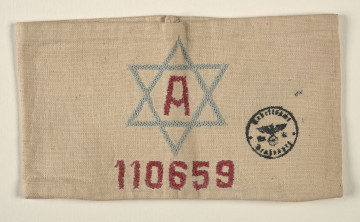
A letter
1945
Museum of the history of Polish Jews
Part of the collection: Krystyna Sigalin (Pajes) heirlooms
Ring shaped to resemble a signet, with a circle embossed and additionally marked with an engraving; overlapping letters N and P (thick, contoured, probably the manufacturer’s initials) are carved within the circle. On the sides of the circle with letters there is a leaf motif (detailed, with marked veins). Additionally, the background – also inside the circle – is decorated with dots (tapped). It belonged to and had also probably been made a prisoner who escaped from one of the so-called death marches – marches of concentration camp prisoners, hurriedly liquidated by the Germans in the areas where the Red Army was approaching. In the spring of 1945, groups of such prisoners were passing through Pulitz. Some prisoners managed to separate unobserved from their groups. A few such refugees were hiding in a woodshed next to the barracks where Krystyna Sigalin and Feliksa Szulc lived.
“One of them – as Krystyna Pajes née Sigalin wrote years later in her memoirs (manuscript in the Museum’s collection) – gave me a small metal ring. […] He made it by himself, in some German arms factory. He turned that ring out of stolen metal, carved a monogram and flowers in it. Who did he do this for? Why did he give it to me? All he had on him was that ring and a small tin box for grass which was to save him from hunger during the march.”
Krystyna Pajes took the ring when leaving for Sweden in March 1968. In 2002, she came to Brandenburg to visit the Death March Museum and commemorate the prisoner who had given her the signet.
Text of the memoir of Krystyna Pajes:
The story of a ring from Germany
After the Warsaw Uprising, as a child, I was deported with the civilian population, driven out of Warsaw by the Germans. I found myself as a forced labourer in the town of Putlitz, Brandenburg. I got there via the camp in Frankfurt/Oder.
In this concentration camp I was registered as Barbara Szulc, daughter of Feliksa Szulc. Feliksa Szulc stated at the registration that our documents were lost during the uprising and that I was her daughter. I enclose a copy of a part of a document issued in the camp in Frankfurt. From the camp we were sent "to work" in a huge estate, which belonged to a family of German aristocrats, the Barons von Putlitz. We had to live in a brick barrack, in a separate room, and sleep in a shared bed. The windows of the room overlooked the road.
Through these windows I saw, in the last days of the war (end of April? beginning of May 1945?) a column of prisoners from concentration camps. The prisoners were wearing blue and white striped uniforms, I had never seen this before.
When the column, escorted by armed soldiers (?), sentries in German uniforms, had a short break in its march, I saw the prisoners cutting grass in a roadside ditch and eating it...
A few prisoners managed to escape during the "standstill", it was just opposite our barrack, so those who managed to run across the road ended up in our yard, behind the house.
The "yard" was a threshing floor, fenced off with wire. There was a storeroom for wood, in which there were also cages with rabbits. I remember exactly how we burnt the prisoners' striped clothes in the kitchen. The inhabitants of our barrack gave some of their civilian clothes to the escapees. The escaped prisoners spoke Polish. They did not know where they were being driven to. Many supposedly died of hunger and exhaustion, or were shot. On the way. Today I know that it was a so-called ["]death march". One of the refugees from the "march" hid in a tree hiding place in the attic. I was supposed to bring him water and food.
That man gave me a ring. The ring, similar to a signet ring, was stamped in white metal and decorated by hand with lines and points. On the front was a monogram [word in bold letters], decorative, the letters I don't remember. Who was it made for? Whose monogram was it? The prisoner made it himself. I knew neither the name nor the surname of the escapee. I kept the ring for many years. It arrived with me, on the long march through Germany, to destroyed Warsaw. It was the end of May 1945.
With time, due to my emigration from Poland in 1969, I gave this ring, historic for me, to Feliksa Szulc's daughter, Małgosia Rybus.
Now, in July 2014, we both decided that, on the eve of the outbreak of the 1944 Uprising, we would give this ring, with this explanation of how it came to be first with me and then with Małgosia Rybus, to some suitable museum.
We decided to give it to the Museum of the History of Polish Jews in Warsaw.
The decision is justified, I was born in Warsaw, on 10 July 1931, as a Jewish child of the Sigalin family, well known in Warsaw.
I survived the war under many false names, one of them being Szulc. Västerås, Sweden.
July 2014
Krystyna Pajes
Author / creator
Dimensions
cały obiekt: diameter: diameter: 1,8 cm
Object type
jewellery
Material
metal
Creation time / dating
Creation / finding place
Owner
POLIN Museum of the History of Polish Jews
Identification number
Location / status

1945
Museum of the history of Polish Jews

1941 — 1942
Museum of the history of Polish Jews
1944 — 1945
Museum of the history of Polish Jews
DISCOVER this TOPIC
National Museum in Lublin
DISCOVER this PATH
Educational path